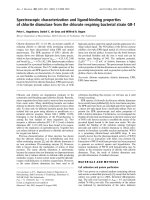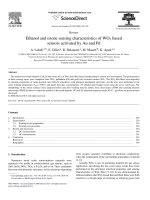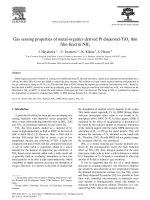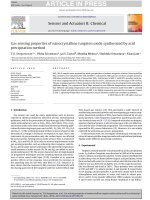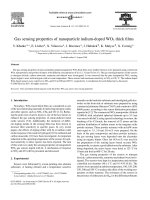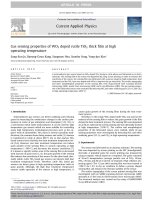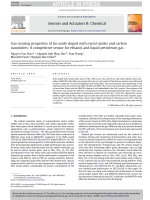- Trang chủ >>
- Khoa Học Tự Nhiên >>
- Vật lý
microstructure characterization and no2 sensing properties of tungsten oxide
Bạn đang xem bản rút gọn của tài liệu. Xem và tải ngay bản đầy đủ của tài liệu tại đây (501.78 KB, 7 trang )
Please cite this article in press as: Y. Qin, et al., Microstructure characterization and NO
2
-sensing properties of tungsten oxide nanostructures,
Sens. Actuators B: Chem. (2010), doi:10.1016/j.snb.2010.06.063
ARTICLE IN PRESS
G Model
SNB-12446; No. of Pages 7
Sensors and Actuators B xxx (2010) xxx–xxx
Contents lists available at ScienceDirect
Sensors and Actuators B: Chemical
journal homepage: www.elsevier.com/locate/snb
Microstructure characterization and NO
2
-sensing properties of tungsten oxide
nanostructures
Yuxiang Qin
∗
, Ming Hu, Jie Zhang
School of Electronics and Information Engineering, Tianjin University, No 92, Weijjin Road, Nankai District, Tianjin 300072, PR China
article info
Article history:
Received 16 November 2009
Received in revised form 28 June 2010
Accepted 29 June 2010
Available online xxx
Keywords:
Tungsten oxide
Nanowires
Nanosheets
Solvothermal synthesis
Gas sensors
abstract
Nanowires and nanosheets of tungsten oxide were synthesized by solvothermal method with differ-
ent tungsten hexachloride (WCl
6
) concentrations in 1-propanol solvent. The morphology and crystal
structure of the tungsten oxide nanostructures were investigated by means of field emission scanning
electron microscope, X-ray diffraction and transmission electron microscope. The specific surface area
and pore size distribution were characterized by Brunauer–Emmett–Teller gas-sorption measurements.
One-dimensional W
18
O
49
nanowire bundles were synthesized at the WCl
6
concentration of 0.01M. With
the concentration increasing to 0.02 M, the structure of the pure two-dimensional WO
3
nanosheets was
formed. The NO
2
gas sensing properties of W
18
O
49
nanowires and WO
3
nanosheets were investigated at
100
◦
Cupto250
◦
C over NO
2
concentration ranging from 1 to 20 ppm. Both nanowires and nanosheets
exhibit reversible response to NO
2
gas at different concentrations. In comparison to WO
3
nanosheets,
W
18
O
49
nanowire bundles showed a much higher response value and faster response–recovery charac-
teristics to NO
2
gas, especially a much quicker response characteristic with response time of 19 s at the
concentration of 5 ppm.
© 2010 Published by Elsevier B.V.
1. Introduction
With theindustrialdevelopment, airpollutionis becomingmore
and moreserious. Especially, nitrogenoxide NO
x
(NO
2
or NO)which
results fromcombustionand automotiveemissions is amain source
of acid rain and photochemical smog [1]. So detection of toxic
NO
x
gas is very important for the environmental protection and
human health. Thus far, several kinds of solid-state NO
2
sensors,
such asresistive[2], capacitive[3],and surfaceacoustic wave (SAW)
[4] types have been developed. In particular, resistive-type sen-
sors based on metal oxide semiconductors are well suited for NO
2
detection owing to their remarkable gas sensing performance and
simple structures [2,5]. Among various metal oxide semiconduc-
tors, tungsten oxide (WO
3−x
), which is a wide band-gap n-type
semiconductor, has been found to be a promising material for
detection of NO
2
gas [6,7]. However, most tungsten oxide sen-
sors based on nanocrystalline powders or films have been studied
widely and shown too slow response–recovery time; and their
sensitivity still needs to make further improvement for practical
application.
In these years, novel nanostructures such as nanowires, nan-
otubes, nanorods and nanobelts, have been evaluated as ideal
candidates for gas sensing applications due to their larger spe-
∗
Corresponding author. Tel.: +86 22 27402372; fax: +86 22 27401233.
E-mail address: (Y. Qin).
cific surface area and smaller dimensions than the Debye length
[8,9]. In fact, gas sensing materials such as SnO
2
[10,11], ZnO [12]
and In
2
O
3
[13] with well-established nanostructure have exhib-
ited higher sensitivity and quicker response to detect gases at
low concentrations than the corresponding thin film materials
[14,15]. Likely, tungsten oxide in nanostructures like nanowires,
nanosheets and nanorods were investigated [16–18], and they
revealed good sensing properties while detecting toxic and haz-
ardous gases. For example, very good results for H
2
S gas sensor
based on tungsten oxide nanowires and nanosheets have been
reported. Chen co-workers [19] found that the single-crystalline
potassium-doped tungsten oxide nanosheets could exhibit high
sensitivity, fast response time and good stability to H
2
S, acetone
and Cl
2
. The investigation of Rao co-workers [20] indicated that
the WO
2.72
nanowires had much higher response value to H
2
S
than the nanoparticles or nanoplatelets of WO
3
. Very recently, Ger-
litz et al. [21] reported that the sensor based on tungsten oxide
nanotubes can detect dilute NO
2
as low as 200 ppb at 200
◦
C and
exhibit response two to three orders-of-magnitude higher than the
one based on WO
3
thin film. These results clearly demonstrate the
potential of tungsten oxide nanostructures in toxic gas detection.
In this work, we synthesized one-dimensional bundled nanowires
and two-dimensional nanosheets of tungsten oxide by the sim-
ple solvothermal method and evaluated their sensing properties
towards NO
2
gas ranging from 1 to 20 ppm at operating temper-
ature of 100–250
◦
C. Our study indicates that both nanowires and
nanosheets of tungsten oxide have high sensitivities to NO
2
gas;
0925-4005/$ – see front matter © 2010 Published by Elsevier B.V.
doi:10.1016/j.snb.2010.06.063
Please cite this article in press as: Y. Qin, et al., Microstructure characterization and NO
2
-sensing properties of tungsten oxide nanostructures,
Sens. Actuators B: Chem. (2010), doi:10.1016/j.snb.2010.06.063
ARTICLE IN PRESS
G Model
SNB-12446; No. of Pages 7
2 Y. Qin et al. / Sensors and Actuators B xxx (2010) xxx–xxx
Furthermore, the nanowires exhibit a much quick response char-
acteristic with response time of 19 s to 5 ppm NO
2
.
2. Experimental
Nanowires and nanosheets of tungsten oxide were synthesized
by solvothermal method with tungsten hexachloride (WCl
6
)as
precursor and 1-propanol as solvent. First, a certain amount of
WCl
6
was dissolved in a little ethanol to form a solution in a
beaker. The ratio of WCl
6
mass to ethanol volume is 0.1 g/ml. Then,
1-propanol was added to the solution which was subsequently
transferred to and sealed in a 100 ml Teflon-lined stainless steel
autoclave. The volume of 1-propanol is80 mland the concentration
of WCl
6
in 1-propanol varied from 0.01 to 0.02M in our experi-
ments. The solvothermal reaction was conducted at 200
◦
C for 9 h
in an electric oven. After that, the autoclave was cooled naturally to
room temperature.Thefinal productswerecentrifuged andwashed
sequentially by deionized water and ethanol several times, and the
obtained powder was dried at 70
◦
C for 6h in air.
The morphology,crystal structure,and phasecomposition ofthe
tungsten oxides were characterized using a field emission scanning
electron microscope (FESEM, FEI Nanosem 430), a X-ray diffrac-
tometer (XRD, RIGAKU D/MAX 2500V/PC, Cu K␣ radiation) and
a field emission transmission electron microscope (FETEM, TEC-
NAI G
2
F-20). In order to evaluate the specific surface area and
pore size distribution of the products, Brunauer–Emmett–Teller
(BET) gas-sorption measurements were carried out using Quan-
tachrome NOVA automated gas-sorption system after the samples
were vacuum-dried at 200
◦
C for 10 h. The specific surface area was
estimated by nitrogen gas isotherms at a relative pressure (P/P
0
)
ranging from 0.005 to 0.1. Pore size distribution was obtained from
the analysis of the desorption branch of nitrogen gas isotherms
using the Barrett–Joyner–Halenda (BJH) model, and total pore
volume was determined by the amount of nitrogen adsorbed at
P/P
0
= 0.99.
The gas sensors were fabricated by spin coating the slurry of
synthesized tungsten oxide nanostructureson the cleaned alumina
substrates which were attached with a pair of interdigitated Pt
electrodes with a thickness of 100 nm. Fig. 1(a and b) shows the
schematic diagrams of the interdigitated electrodes and the sensor
respectively. The electrodes were deposited using RF magnetron
sputtering method. The coating slurry was prepared by ultrasoni-
cally dispersing tungsten oxide powders in mixed organic solvents
of terpineol and ethanol with 2:1 volume ratio for 2 h. A physical
mask is used during spin coating to avoid the presence of slurry
at the end of the substrate. The coated sensing films were dried in
air for 30 min subsequently annealed at 300
◦
C for 1 h at ambient
atmosphere in order to burn out the organic solvent used in prepa-
ration of coating paste and to enhance the adherence of the sensing
film to the sensor substrates. Temperature was raised from ambi-
ent to 300
◦
C using a slow ramp of 2.5
◦
C/min in order to avoid the
occurrence of cracks in the films.
The NO
2
gas sensing measurements were carried out in a
home-built computer-controlled static gas sensing characteriza-
tion system consisting of a glass test chamber, a flat heating plate,
a professional digital multimeter and a data acquisition system.
The schematic diagram of the gas sensing test system is shown in
Fig. 1(c). The sensors were placed on the heating plate fixed in test
chamber. The pure NO
2
gas was injected into the chamber directly
to get the desired concentration, and the sensor was recovered by
opening thetop coverof thetest chamberand settingup the electric
blower fixed at the bottom of the chamber. An UNI-T UT70D pro-
fessional digital multimeter with the function of measuring range
automatic adjustment was used for continuously monitoring the
resistance change of the sensors during the whole measurement
process. The electrically connection between the Pt electrodes and
Fig. 1. Schematic diagrams of the interdigitated Pt electrodes (a), the sensor (b) and
the gas sensing test system (c).
the digital multimeter was realized by a pair of elastic Au-coated
copper probes. The acquired resistance data were stored in a PC for
further analysis. The sampling interval was set to 1 s. The operating
temperature of the sensing films was changed from 100 to 250
◦
C
by adjusting the temperature controller of heat plate. The sensor
response (S) was defined as S =(R
g
− R
0
)/R
0
, where R
g
and R
0
are
the resistance of the sensor in the measuring gas and that in clean
air, respectively. The response time is defined as the time required
for the resistance rising to 90% of the equilibrium value since the
test gas is injected. Conversely, therecovery time is the time for the
resistance in equilibrium to go down to 10% of the original value in
air since the test gas is released.
3. Results and discussion
3.1. Structural characterization
The morphologies of tungsten oxide nanostructures synthe-
sized at different WCl
6
concentrations after annealing at 300
◦
C
for 1 h were shown in Fig. 2(a–d). It can be seen from Fig. 2(a),
Please cite this article in press as: Y. Qin, et al., Microstructure characterization and NO
2
-sensing properties of tungsten oxide nanostructures,
Sens. Actuators B: Chem. (2010), doi:10.1016/j.snb.2010.06.063
ARTICLE IN PRESS
G Model
SNB-12446; No. of Pages 7
Y. Qin et al. / Sensors and Actuators B xxx (2010) xxx–xxx 3
Fig. 2. (a, c, d) SEM images of tungsten oxide nanostructures synthesized at WCl
6
concentration of 0.01M, 0.015M and 0.02 M, respectively, after annealing at 300
◦
C for 1h.
(b) TEM image of the annealed tungsten oxide synthesized at 0.01M. The insets in (a) and (d) are the SEM images of the corresponding product before annealing.
the product synthesized at the WCl
6
concentration of 0.01 M after
thermal annealing exhibited one-dimensional nanowire bundles
features with diameters in 70–90 nm and lengths in 500–1000 nm.
Further TEM examination can identify their bundled feature, giv-
ing evidence that many nanowires with diameters of about 10 nm
assembled alongtheir maingrowth direction andformed abundled
structure, asshown in the Fig. 2(b). Comparedwith thebundle mor-
phology before annealing shown in the inset in Fig. 2(a), it can be
seen that the thermal annealing results in the nanowire bundles
becoming thicker, shorter and straighter, indicating that a possi-
ble agglomeration had occurred. Increasing WCl
6
concentration to
0.015 M, apparent evolution of the morphology can be observed.
The SEM image shown in Fig. 2(c) exhibited the annealed prod-
uct was a mixture structure of nanowires and nanosheets. Up to
a high WCl
6
concentration of 0.02 M, a pure nanosheets structure
with thicknesses of 10–30 nm was formed (inset in Fig. 2(d)), and
showed unobvious change after annealing treatment (Fig. 2(d)).
From above results, it can be speculated that the WCl
6
concentra-
tion has a great effect on the specific morphologies of tungsten
oxide nanostructures synthesized by solvothermal method. This is
in good agreement with the previous report [22]. Lower solution
concentration contributedto the lower supersaturation oftungsten
source, promoting the growth of tungsten oxide nanowires [23].
At higher concentration, the highly saturated WCl
6
could prohibit
the growth of tungsten oxide nanowires along the main growth
direction.
XRD analysis was carried out to identify the crystalline struc-
ture of the tungsten oxide before and after annealing at 300
◦
C for
1h. Fig. 3(a, c, e) and (b, d, f) respectively shows the XRD pat-
terns of the as-synthesized and annealed samples. As shown in
Fig. 3(a), the main diffraction peaks of the bundled nanowires syn-
thesized at WCl
6
concentration of 0.01 M can be well indexed as
the monoclinic cell of W
18
O
49
with cell parameters of a =18.32 Å,
b =3.79 Å, c = 14.04 Å and ˇ = 115.04
◦
(JCPDS No. 65-1291). The
strongest peak intensity of (0 10) plane indicates that the crys-
Fig. 3. XRD patterns of tungsten oxide nanostructures: (a, c, e) nanowires, mixture
and nanosheets synthesized at WCl
6
concentrations of 0.01 M, 0.015 M and 0.02 M,
respectively, before annealing, (b, d, f) nanowires, mixture and nanosheets after
annealing.
Please cite this article in press as: Y. Qin, et al., Microstructure characterization and NO
2
-sensing properties of tungsten oxide nanostructures,
Sens. Actuators B: Chem. (2010), doi:10.1016/j.snb.2010.06.063
ARTICLE IN PRESS
G Model
SNB-12446; No. of Pages 7
4 Y. Qin et al. / Sensors and Actuators B xxx (2010) xxx–xxx
Table 1
Measured resistances and sensor responses in the presence of 5ppm of NO
2
for tungsten oxide nanowires and nanosheets as a function of temperature.
Operating temperature (
◦
C)
W
18
O
49
nanowires WO
3
nanosheets
Baseline
resistance
(M)
Equilibrium
resistance
(M)
Sensor response Baseline
resistance
(M)
Equilibrium
resistance
(M)
Sensor
response
100 43.9 ± 0.8 631.7 ± 9.7 13.4 ± 0.5 44.2 ± 0.7 535.2 ± 31.0 11.1 ± 0.9
125 9.6 ± 0.4 1020.7 ± 39.1 105.1 ± 0.5 10.1 ± 0.7 665.6 ± 40.6 65.2 ± 0.5
150 3.1 ± 0.1 468.8 ± 12.7 151.2 ± 0.5 3.3 ± 0.4 354.1 ± 43.1 107.3 ± 0.3
175 2.1 ± 0.1 307.1 ± 9.8 144.6 ± 0.4 1.3 ± 0.1 121.3 ± 15.5 95.2 ± 0.4
200 1.8 ± 0.04 226.7 ± 4.6 123.6 ± 0.3 0.6 ± 0.1 42.5 ± 9.2 73.5 ± 0.4
225 1.4 ± 0.1 68.6 ± 2.9 48.0 ± 0.2 0.6 ± 0.1 13.7 ± 1.7 21.1 ± 0.2
250 1.1 ± 0.1 2.4 ± 0.1 1.2 ± 0.1 0.7 ± 0.1 8.0 ± 0.7 10.2 ± 0.1
Fig. 4. BET plots of N
2
adsorption isothermsfor tungstenoxide nanostructures after
annealing at 300
◦
C for 1 h.
tal grows preferentially along the b-axis, i.e. the [0 10] direction.
The XRD pattern of the nanosheets obtained at WCl
6
concentration
of 0.02 M corresponds to the monoclinic structure of WO
3
with
lattice of a= 7.297Å, b = 7.539 Å, c =7.688 Å and ˇ =90.91
◦
(JCPDS
No. 43-1035), seen in Fig. 3(e). From this XRD pattern, the two
strongest diffraction peaks appear at 2Â = 23.58
◦
and 2Â = 24.34
◦
corresponding to (0 20) and (2 00) facets and the peak intensity of
the (0 02) reflection is muchweaker, which implies the nanosheets
grow along the [0 10] and [1 00] crystallographic direction and
is enclosed by ±(0 01) facets. The sample synthesized at WCl
6
concentrations of 0.015 M is a mixture of monoclinic W
18
O
49
and
monoclinic WO
3
according to the XRD analysis in Fig. 3(c), which
is in accordance with the SEM characterization result shown in
Fig. 2(c). Fig. 3 shows the comparison between the XRD patterns
of the samples before and after thermal annealing. It is obvious
that the crystal structures of the W
18
O
49
nanowires and WO
3
nanosheets remained unchanged by the annealing treatment at
300
◦
C. However, the much sharper peaks observed in the XRD pat-
terns of the annealed tungsten oxides indicated an increase degree
of crystallinity.
3.2. Physical adsorption–desorption measurements
To examine the porous structure of the W
18
O
49
nanowire bun-
dles and WO
3
nanosheets, the specific surface area and pore size
distribution of the samples annealed at 300
◦
C for 1 h are deter-
mined by the physical adsorption–desorption measurements in N
2
gas. BET plots of N
2
gas adsorption isotherms for tungsten oxide
nanostructures are shown in Fig. 4. Here, W is the weight of N
2
gas adsorbed at a relative pressure P/P
0
. P/P
0
is the pressure of N
2
gas divided by its saturation vapor pressure. It can be seen that
the data points are on a straight line for every sample, suggest-
Fig. 5. Pore size distributions per unit mass of tungsten oxide nanowires and
nanosheets after annealing at 300
◦
C for 1 h.
ing that the specific surface area determined by BET analysis is
reliable.
The pore size distributions per unit mass of the annealed sam-
ples determined by adsorption–desorption isotherms of N
2
gas
using the BJH model are represented in Fig. 5. Y-axis represents the
pore surface area when the pore size is in a certain range. The pore
surface area and the pore size distribution above 8 nm appear sim-
ilar between W
18
O
49
nanowires and WO
3
nanosheets. But when
the pore size is less than 8 nm, some discrepancy occurs. W
18
O
49
nanowires show larger pore surface areas than WO
3
nanosheets.
Meanwhile, it can be seen that for W
18
O
49
nanowires, the pore size
distribution has a peak at about 2.1 nm, while the pore size distri-
bution peak shifts to a larger size of 2.3 nm for WO
3
nanosheets.
The measured specific surface area and pore volume of
the annealed bundled W
18
O
49
nanowires are 72.03 m
2
/g and
0.13 cc/g, whilst for the WO
3
nanosheets they are 41.85 m
2
/g
and 0.12 cc/g, respectively. These values are slight lower than
those obtained from the samples before annealing. For the as-
synthesized W
18
O
49
nanowires and WO
3
nanosheets, the specific
surface area and pore volume are respectively 89.89 m
2
/g/0.14 cc/g
and 46.67 m
2
/g/0.12 cc/g. The relative higher specific surface area
of W
18
O
49
nanowires than that of WO
3
nanosheets is related to the
bundles feature. The individual nanowires comprising the bundles
were observed in thin and long one-dimensional nanostructured
materials from the SEM and TEM images shown in Fig. 2(a and
b). It’s obvious that the high specific surface area of the bundled
nanowires is in part ascribed to a combination of the ultra-thin
feature of individual nanowires and the unique packing character-
istic of the bundles themselves [24]. Also, it is associated with the
sizes and distributions of the pores [25], which can be proved from
Fig. 5. Theformation ofnanosheets structurewill consequently lead
to the decrease of pore surface area, which in turn resulted in the
decreased pore volume and specific surface areas.
Please cite this article in press as: Y. Qin, et al., Microstructure characterization and NO
2
-sensing properties of tungsten oxide nanostructures,
Sens. Actuators B: Chem. (2010), doi:10.1016/j.snb.2010.06.063
ARTICLE IN PRESS
G Model
SNB-12446; No. of Pages 7
Y. Qin et al. / Sensors and Actuators B xxx (2010) xxx–xxx 5
3.3. NO
2
-sensing properties
The gas sensing properties of the sensors based on tungsten
oxide nanostructures towards 5 ppm NO
2
were tested at operating
temperatures ranging from 100 to 250
◦
C. Table 1 shows the mea-
sured baseline resistances, equilibrium resistances and calculated
sensor responses for the W
18
O
49
nanowires and WO
3
nanosheets,
respectively, as a function of operating temperature. It should be
noted that three continual tests were preformed to the same sen-
sor sample at every operating temperature in order to ensure the
reliability of the testing data. The baseline resistances and the equi-
librium resistances in three tests were found to be similar, and
every data shown in Table 1 is the average value of three data
obtained from three tests respectively. The standard deviations for
each valuewere also shownin the table. From Table1, it canbe seen
that the baseline resistances of tungsten oxide decrease along with
increasing temperature, which is consistent with typical semicon-
ductor materials. It is well known that the response of the sensor
is much dependent on the operating temperatures. Such relation
is illustrated in Table 1. The response tests’ results show maxi-
mum values of 151.2 and 107.3 at 150
◦
C for the W
18
O
49
nanowires
and WO
3
nanosheets, respectively. When operating temperature
is above 200
◦
C, the nanowires and nanosheets lose their response
ability quickly. Especially, for W
18
O
49
nanowires, the response
value at 250
◦
C only was 1.2, which is less than 1% percent of that
at 150
◦
C. The above results can be understood as following: As
been reported, tungsten oxide is a typical n-type semiconductor,
and its gas sensing mechanism belongs to the surface-controlled
type, and the change of conductivity is dependent on the species
and the amount of chemisorbed oxygen on the surface [26].Atlow
temperature, oxygen species on the film surface are not active, so
that a low interaction happens between adsorbed oxygen species
and detected NO
2
gas. Thus, the response of the tungsten oxide
film is low. Conversely, some of the adsorbed oxygen species may
be desorbed from the film surface at high temperature, which also
leads to low response value. As a result, there should be an optimal
operating temperature to balance the above two effects in order
to achieve the maximum gas response. It is clear from Table 1 that
the measurement carried out at temperatures ranging from 150
to 200
◦
C can obtain relatively high NO
2
response, and the highest
response is achieved at 150
◦
C. From Table 1,W
18
O
49
nanowires
exhibited much higher NO
2
response than WO
3
nanosheets at dif-
ferent operating temperature ranging from 100 to 200
◦
C. While it
is noteworthy that, at 250
◦
C, the NO
2
response of WO
3
nanosheets
sensor is almost 10 times higher than that of W
18
O
49
nanowires
sensor.
The response and recovery time of the W
18
O
49
nanowires and
WO
3
nanosheets to 5 ppm NO
2
at various operating temperatures
are shownin Fig.6. Fromthis figure, the response timeand recovery
time of the two samples are both decrease quickly with increasing
operating temperature. When the operating temperature rise to
200
◦
C or above, both samples show the much fast response and
recovery characteristics, despite of their low response shown in
Table 1. It is also clear from this figure that the W
18
O
49
nanowires
show fasterresponse–recoverythan theWO
3
nanosheets atvarious
operating temperatures.
Fig. 7 shows the dynamic responses of tungsten oxide nanos-
tructures to NO
2
gas in varying concentration. The operating
temperature is 200
◦
C. Fig. 7(a and b) shows the results of the
W
18
O
49
nanowires and WO
3
nanosheets synthesized at WCl
6
con-
centrations of 0.01 M and 0.02 M, respectively. As shown in this
figure, the measured resistances increased upon exposure to NO
2
gas. This result is expected because the oxidizing analyte NO
2
withdraws electrons from the n-type tungsten oxide surface and
induces the formation of electron-depleted space-charge layers
[27]. Notably, the resistances could almost recover to its initial
Fig. 6. Response time and recovery time of tungsten oxide nanowires and
nanosheets to 5 ppm NO
2
as a function of operating temperature.
value after NO
2
removal, indicating a good reversibility of these
nanostructure materials. From this figure, it also can be seen that
the increase in the resistance of the W
18
O
49
nanowires upon expo-
sure to NO
2
is much larger than that of the WO
3
nanosheets, which
indicates that the W
18
O
49
nanowires have higher NO
2
response.
The response values of the W
18
O
49
nanowires upon exposure to 1,
5, 10 and 20 ppm NO
2
are 13.4, 123.6, 203.4 and 332.3, while those
of the WO
3
nanosheets are 13.3,73.5, 144.2 and279.8, respectively.
As has been reported, the gas sensing mechanism of tung-
sten oxide belongs to the surface-controlled type in which the
surface states and oxygen adsorption play an important role
[26,28]. Atmospheric oxygen adsorbs electrons from the conduc-
tion band of the sensing metal oxide and occurs on the surface
Fig. 7. Dynamic response of (a) bundled W
18
O
49
nanowires, (b) WO
3
nanosheets to
varying NO
2
concentration at an operating temperature of 200
◦
C.
Please cite this article in press as: Y. Qin, et al., Microstructure characterization and NO
2
-sensing properties of tungsten oxide nanostructures,
Sens. Actuators B: Chem. (2010), doi:10.1016/j.snb.2010.06.063
ARTICLE IN PRESS
G Model
SNB-12446; No. of Pages 7
6 Y. Qin et al. / Sensors and Actuators B xxx (2010) xxx–xxx
Fig. 8. Response time and recovery time curves of W
18
O
49
nanowires and WO
3
nanosheets to different NO
2
concentration at an operating temperature of 200
◦
C.
in the form of O
−
,O
2−
and O
2
−
. The reaction between NO
2
and
the surface adsorbed species (O
2
−
,O
−
and O
2−
, etc.) induces
the formation of electron-depleted space-charge layers inside the
tungsten oxide surfaces and thus the increase in the resistance
[29]. According to the BET measurements, the W
18
O
49
nanowires
showed much larger specific surface area (72.03 m
2
/g) than the
WO
3
nanosheets (41.85 m
2
/g). The larger surface area can provide
more adsorption–desorption sites and a larger amount of surface
adsorbed oxygen species interacting with detected gas molecules.
Thus, W
18
O
49
nanowires with higher specific surface area show
much larger change in resistance upon exposure to NO
2
than the
WO
3
nanosheets with lower specific surface area. Besides, non-
stoichiometric crystal structure of W
18
O
49
is another important
factor for highresponse [30]. There existmuch more oxygenvacan-
cies inthecrystal structureof non-stoichiometricW
18
O
49
than fully
oxidized WO
3
[31], and the large amounts of oxygen vacancies can
serve as adsorption sites of gas molecular and effect on the elec-
tron density in oxide, which is beneficial to achieving much higher
gas response [32,33]. Above analysis can explain why the W
18
O
49
nanowires exhibithigher responsethan theWO
3
nanosheets. How-
ever, as shown in Table 1, the NO
2
response of WO
3
nanosheets
is higher than that of W
18
O
49
nanowires for almost 10 times at
the operating temperature of 250
◦
C. This result implies that some
other factor dominates the gassensing performance ofthe one- and
two-dimension tungstenoxidenanostructure. Itis foundfrom Fig.2
that thermal treatment resulted in a more evident change in the
microstructure of W
18
O
49
nanowires than that of WO
3
nanosheets,
indicating that the microstructure of W
18
O
49
nanowires is much
more sensitive to temperature than WO
3
nanosheets. Therefore, it
is possible that the microstructure change of W
18
O
49
nanowires
(e.g. further agglomeration) at high operating temperature affects
the gas diffusion and then induces the much low response. Accord-
ing to this analysis, WO
3
nanosheets might show much better
stability in the gas response due to much better thermal stability
in the microstructure in comparison withW
18
O
49
nanowires when
operating at high temperature.
Fig. 8 shows the response and recovery time curves of the
W
18
O
49
nanowires and WO
3
nanosheets to different concentra-
tion of NO
2
at 200
◦
C. It can be seen that, for the tungsten oxide
nanowires and nanosheets, the response times decrease whereas
the recovery times increase with rising concentration of NO
2
.
Worth of mention is the faster response–recovery of the W
18
O
49
nanowires compared to that of the WO
3
nanosheets when both
expose to the same NO
2
concentration. Especially, the W
18
O
49
nanowires exhibit very fast responsecharacteristic to NO
2
gas with
the response times of42, 19, 16 and 14 s to 1, 5, 10 and 20ppm NO
2
,
respectively.
4. Conclusions
One- and two-dimensional tungsten oxidenanostructures were
synthesized at 200
◦
C by solvothermal method with tungsten hex-
achloride (WCl
6
) as precursor and 1-propanol as solvent. The
synthesis processes were preformed at different WCl
6
concen-
trations (0.01, 0.015 and 0.02 M, respectively). One-dimensional
W
18
O
49
nanowire bundles were obtained at a WCl
6
concen-
tration of 0.01 M, while the structure of pure two-dimensional
WO
3
nanosheets was formed at concentration of 0.02 M. Thermal
annealing at 300
◦
C could not change the crystal structure of the
nanowires and nanosheets.BET measurements showedthe specific
surface areas and pore volumes were 72.03 m
2
/g and 0.13 cc/g for
annealed W
18
O
49
nanowire bundles and 41.85 m
2
/g and 0.12 cc/g
for annealed WO
3
nanosheets, respectively. The gas sensing prop-
erties measurements indicated that both W
18
O
49
nanowires and
WO
3
nanosheets exhibit reversible response to different concen-
trations of NO
2
. Compared to WO
3
nanosheets, W
18
O
49
nanowires
showed quicker response–recovery and higher response value to
different concentration of NO
2
gas due to the high specific sur-
face area and the non-stoichiometric crystal structure, and their
response time, recovery time andresponse value are 19 s, 112 s and
123.6 to 5 ppm NO
2
at 200
◦
C, respectively. These results indicate
the one-dimensional W
18
O
49
nanowire is a promising gas sensing
material for high performance NO
2
gas sensor.
Acknowledgments
This work was financially supported by the National Natural
Science Foundation (No. 60801018, 60771019), Tianjin Natural
Science Foundation (No. 09JCYBJC01100) and the New Teacher
Foundation of Ministry of Education (No. 200800561109) of China.
References
[1] G. Eranna,B.C.Joshi, D.P. Runthala,R.P. Gupta, Oxidematerialsfor development
of integrated gas sensors-a comprehensive review, Crit. Rev. Solid State Mater.
Sci. 29 (2004) 111–188.
[2] A. Ruiz, A. Cornet, G. Sakai, K. Shimanoe, J.R. Morante, N. Yamazoe, Prepara-
tion of Cr-doped TiO
2
thin film of P-typeconduction for gas sensor application,
Chem. Lett. 31 (2002) 892–893.
[3] C. Zamani, K. Shimanoe, N. Yamazoe, A new capacitive-type gas sensors com-
bining an MIS with a solid electrolyte, Sens. Actuators B 109 (2005) 216–220.
[4] M.S. Nieuwenhuizen, A.J. Nederlof, Preliminary results with a silicon-based
surface acoustic wave chemical sensor for NO
2
, Sens. Actuators B 19 (1989)
385–392.
[5] G. Sberveglieri, P. Benussi, G. Coccoli, S. Groppelli, P. Nelli, Reactively sputtered
indium tin oxide polycrystalline thin films as NO and NO
2
gas sensors, Thin
Solid Films 186 (1990) 349–360.
[6] M. Akiyama, J. Tamaki, N. Miura, N. Yamazoe, Tungsten oxide-based semicon-
ductor sensor highly sensitive to NO and NO
2
, Chem. Lett. (1991) 1611–1614.
[7] Y.K. Chung, M.H. Kim, W.S. Um, H.S. Lee, J.K. Song, S.Ch. Choi, K.M. Yi, M.J. Lee,
K.W. Chung, Gas sensing properties of WO
3
thick film for NO
2
gas dependent
on process condition, Sens. Actuators B 60 (1999) 49–55.
[8] Z.W. Pan, Z.R. Dai, Z.L. Wang, Nanobelts of semiconducting oxides, Science 291
(2001) 1947–1949.
[9] Y. Cui, C.M. Lieber, Functional nanoscale electronic devices assembled using
silicon nanowire building blocks, Science 291 (2001) 851–853.
[10] A. Kolmakov, D.O. Klenov, Y. Lilach, S. Stemmer, M. Moskovits, Enhanced gas
sensing by individual SnO
2
nanowires and nanobelts functionalized with Pd
catalyst particles, Nano Lett. 5 (2005) 667–673.
[11] Y.B. Shen, T. Yamazaki, Z.F. Liu, D. Meng, T. Kikuta, N. Nakatani, M. Saito, M.
Mori, Microstructure, H
2
gas sensing propertiesofundopedand Pd-doped SnO
2
nanowires, Sens. Actuat. B 135 (2009) 524–529.
[12] Y.Z. Lv, L. Guo, H.B. Xu, X.F. Chu, Gas-sensing properties of well-crystalline ZnO
nanorods grown by simple route, Physica E 36 (2007) 102–105.
[13] C.Y. Wang, M.Ali, T. Kups, C C.Röhlig, V. Climalla, T.Stauden,O. Ambacher, NO
x
sensing properties of In
2
O
3
nanoparticles prepared by metal organic chemical
vapour deposition, Sens. Actuators B 130 (2008) 589–593.
[14] Z.F. Liu, T. Yamazaki, Y.B. Shen, T. Kikuta, N. Nakatani, Y.X. Li, O
2
and CO sensing
of Ga
2
O
3
multiple nanowire gassensors, Sens. ActuatorsB 129 (2008) 666–670.
[15] L.C. Tien, P.W. Sadik, D.P. Norton, L.F. Voss, S.J. Pearton, H.T. Wang, B.S. Kang, F.
Ren, J. Jun, J. Lin, Hydrogen sensing at room temperature with Pt-coated ZnO
thin films and nanorods, Appl. Phys. Lett. 87 (2005) 222106.
Please cite this article in press as: Y. Qin, et al., Microstructure characterization and NO
2
-sensing properties of tungsten oxide nanostructures,
Sens. Actuators B: Chem. (2010), doi:10.1016/j.snb.2010.06.063
ARTICLE IN PRESS
G Model
SNB-12446; No. of Pages 7
Y. Qin et al. / Sensors and Actuators B xxx (2010) xxx–xxx 7
[16] S.B. Sun, Z.D. Zou, G.H. Min, Synthesis of bundled tungsten oxide nanowires
with controllable morphology, Mater. Charact. 60 (2009) 437–440.
[17] R. Hu, H.S. Wu, K.Q. Hong, Growth of uniform tungsten oxide nanowires with
small diameter via a two-step heating process, J. Cryst. Growth 306 (2007)
395–399.
[18] R.F. Mo, G.Q. Jin, X.Y. Guo, Morphology evolution of tungsten trioxide nanorods
prepared by an additive-free hydrothermal route, Mater. Lett. 61 (2007)
3787–3790.
[19] B. Zhang,J.D.Liu, S.K. Guan,Y.Z. Wang, Y.Z. Zhang,R.F. Chen, Synthesis ofsingle-
crystalline potassium-doped tungsten oxide nanosheets as high-sensitive gas
sensors, J. Alloys Compd. 439 (2007) 55–58.
[20] C.S. Rout, M. Hegde, C.N.R. Rao, H
2
S sensors based on tungsten oxide nanos-
tructures, Sens. Actuators B 128 (2008) 488–493.
[21] R.A. Gerlitz, K.D. Benkstein, D.L. Lahr, J.L. Hertz, C.B.Montgomery, J.E. Bonevich,
S. Semancik, M.J. Tarlov, Fabrication and gas sensing performance of parallel
assemblies of metal oxide nanotubes supported by porous aluminum oxide
membranes, Sens. Actuators B 136 (2009) 257–264.
[22] J. Moon, M.L. Carasso, H.G. Krarup, J.A. Kerchner, J.H. Adair, Particle-shape con-
trol and formation mechanisms of hydrothermally derived lead titanate, J.
Mater. Res. 14 (1999) 866–875.
[23] H.G. Choi, Y.H. Jung, D.K. Kim, Solvothermal synthesis of tungsten oxide
nanorod/nanowire/nanosheet, J. Am. Ceram. Soc. 88 (2005) 1684–1686.
[24] J. Pfeifer, E. Badaljan, P. TekulaBuxbaum, T. Kovacs, O. Geszti, A.L. Toth, Growth
and morphology of W
18
O
49
crystals produced by microwave decomposition of
ammonium paratungstate, J. Cryst. Growth 169 (1996) 727–733.
[25] Y.M. Zhao, W.B. Hu, Y.D. Xia, E.F. Smith, Y.Q. Zhu, C.W. Dunnill, Preparation and
characterization of tungsten oxynitride nanowires, J. Mater. Chem. 17 (2007)
4436–4440.
[26] J. Mizsei, How can sensitive and selective semiconductor gas sensors be made,
Sens. Actuators B 23 (1993) 173–176.
[27] C.O. Park, S.A. Akbar, Ceramics for chemical sensing, J. Mater. Sci. 38 (2003)
4611–4637.
[28] A. Rothschild, Y. Komem, The effect of grain size on the sensitivity of nanocrys-
talline metal-oxide gas sensors, J. Appl. Phys. 95 (2004) 6374–6380.
[29] J. Tamaki, Z. Zhang, K. Fujimori, M. Akiyama, T. Harada, N. Miura, N. Yama-
zoe, Grain-size effects in tungsten oxide-based sensor for nitrogen oxides, J.
Electrohem. Soc. 141 (1994) 2207–2210.
[30] Y.M. Zhao,Y.Q. Zhu, Room temperature ammoniasensing properties ofW
18
O
49
nanowires, Sens. Actuators B 137 (2009) 27–31.
[31] C.C. Liao, F.R. Chen, J.J. Kai, Annealing effect on electrochromic properties of
tungsten oxide nanowires, Sol. Energy Mater. Sol. Cells 91 (2007) 1258–1266.
[32] W. Göpel, K.D. Schierbaum, SnO
2
sensors: current status and future prospects,
Sens. Actuators B 26–27 (1995) 1–12.
[33] I. Jiménez, M.A. Centeno, R. Scotti, F. Morazzoni, A. Cornet, J.R. Morante, NH
3
interaction with catalytically modified nano-WO
3
powders for gas sensing
applications, J. Electrochem. Soc. 150 (2003) 72–80.
Biographies
Yuxiang Qin received a Ph.D. in microelectronics and solid-state electronics from
Tianjin University in 2007. She is currently an associate professor in Department of
Electronics Science and Technology in Tianjin University. Her research interest is in
the areas of oxide semiconductor gas sensor, field emission materials and devices.
Ming Hu received a M.S. in microelectronics and solid-stateelectronics from Tianjin
University in 1991. She is now a professor in Department of Electronics Science and
Technology in Tianjin University. Her research interests include MEMS, gas sensor,
functional film devices.
Jie Zhang received her Bachelor degree in microelectronics and solid-state elec-
tronics from Tianjin University in 2008. She is now a graduate student at Tianjin
University. Her current research is focused on the tungsten oxide based gas sensor
and material adsorption properties simulation.
